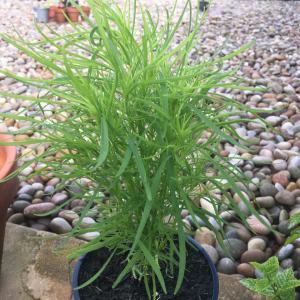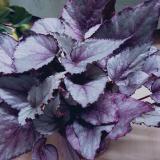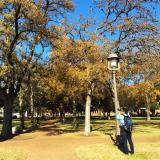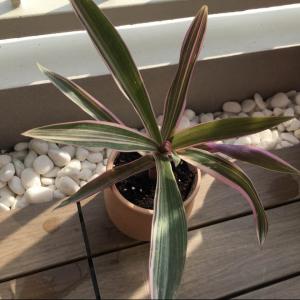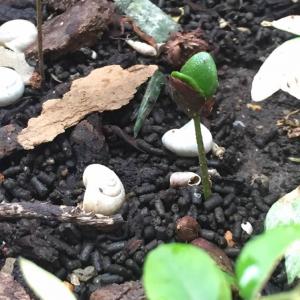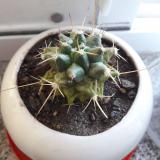文章
Dummer. ゛☀
2017年08月03日

Family - Salicaceae
Stems - Multiple from the base, woody, erect to ascending or reclining. A shrub to +5m tall. Twigs glabrous or with a few sparse hairs, terete, with spongy white pith, green or reddish in strong sun. New growth sericeous, green.
Leaves - Alternate, short-petiolate. Petioles to 3mm long, whitish green, glabrous or with some sericeous hairs. Blades linear-oblong, , mostly glabrous above, sericeous or not below, deep shiny green above, dull green below, acute, with unevenly-spaced shallow teeth on the margins (the teeth small and less than 13 per inch).
Inflorescence - (pistillate) - Terminal spike on new season's growth. Spike to +/-4cm long in flower, elongating in fruit to +8cm long. Axis of the inflorescence sericeous to tomentose, light green. Each flower subtended by and partially enclosed by one cupped bract. Bracts enclosing the flowers for about 2/3 of the total flower length. Bracts light green, ovate, sericeous, rounded at the apex, 2-3mm long in flower, -2mm broad. Flowers ascending, tightly overlapping, spiraled around the axis.
Flowers - (pistillate) - Green, sericeous, to +4mm long in flower, longer in fruit. Stigmas 2, each divided and appearing as 4, white in flower, -1mm long, spreading, sessile. Styles wanting. Ovary with many ovules. Staminate flowers not seen. Fruits brown, splitting into 2 halves vertically. Seeds comose. Coma white, like silk, 5-8mm long. Seeds brown, -1mm long, .2mm broad, cylindric.
Flowering - May - June.
Habitat - Sand bars, gravel bars, mud flats, streambanks, oxbow lakes, river bottoms, flood plains.
Origin - Native to U.S.
Other info. - This species of Willow is common throughout nearly all of Missouri except in the bootheel of the state, where it is apparently absent. This species is typically found as a small shrub on gravel bars and mudflats. The plant spreads by underground stems and can form large colonies if left unchecked.
The pubescence of all parts of the plant is variable.
Stems - Multiple from the base, woody, erect to ascending or reclining. A shrub to +5m tall. Twigs glabrous or with a few sparse hairs, terete, with spongy white pith, green or reddish in strong sun. New growth sericeous, green.
Leaves - Alternate, short-petiolate. Petioles to 3mm long, whitish green, glabrous or with some sericeous hairs. Blades linear-oblong, , mostly glabrous above, sericeous or not below, deep shiny green above, dull green below, acute, with unevenly-spaced shallow teeth on the margins (the teeth small and less than 13 per inch).

Inflorescence - (pistillate) - Terminal spike on new season's growth. Spike to +/-4cm long in flower, elongating in fruit to +8cm long. Axis of the inflorescence sericeous to tomentose, light green. Each flower subtended by and partially enclosed by one cupped bract. Bracts enclosing the flowers for about 2/3 of the total flower length. Bracts light green, ovate, sericeous, rounded at the apex, 2-3mm long in flower, -2mm broad. Flowers ascending, tightly overlapping, spiraled around the axis.

Flowers - (pistillate) - Green, sericeous, to +4mm long in flower, longer in fruit. Stigmas 2, each divided and appearing as 4, white in flower, -1mm long, spreading, sessile. Styles wanting. Ovary with many ovules. Staminate flowers not seen. Fruits brown, splitting into 2 halves vertically. Seeds comose. Coma white, like silk, 5-8mm long. Seeds brown, -1mm long, .2mm broad, cylindric.

Flowering - May - June.
Habitat - Sand bars, gravel bars, mud flats, streambanks, oxbow lakes, river bottoms, flood plains.
Origin - Native to U.S.
Other info. - This species of Willow is common throughout nearly all of Missouri except in the bootheel of the state, where it is apparently absent. This species is typically found as a small shrub on gravel bars and mudflats. The plant spreads by underground stems and can form large colonies if left unchecked.
The pubescence of all parts of the plant is variable.
0
0
成长记
meriunkat
2017年08月02日

I new added a "Unknown" in my "garden"


1
0
meriunkat:@奇怪终结者 this is the biggest it gets though
奇怪终结者:It looks like Greenovia.
文章
Dummer. ゛☀
2017年08月02日

Family - Anacardiaceae
Stems - Woody, to +/-8m tall, typically with a single trunk but forming colonies from stolons, with sticky sap(sap quickly darkening with exposure to air). New seasons twigs densely pilose, tan to slightly reddish.
Leaves - Alternate, odd-pinnate, petiolate. Petiole and rachis densely pilose, slightly reddish. Petioles to +5cm long. Leaflets opposite, typically 11-31 per leaf, sessile, serrate, acute to acuminate, elliptic-lanceolate to linear-lanceolate, pubescent to glabrate and deep green above. Dull green below.
Inflorescence - Terminal thryse. Axis and branches of thryse densely pilose. Pistillate inflorescence smaller but much more dense than staminate inflorescence. Pistillate inflorescence to +11cm long(tall), +/-5cm in diameter. Branches of thryse each subtended by a long attenuate bract. Bracts to 2cm long, 2-3mm broad at base, densely pilose. Staminate inflorescence more of a pyramid shape than pistillate. Plants polygamo-dioecious.
Flowers - Petals 5, greenish-yellow, 2.1mm long, oblong to rotund, glabrous, spreading to reflexed. Sepals 5, alternating with petals, acute to acuminate, greenish. Pistillate flowers often with staminal vestiges. Style 3-parted, +/-.5mm long. Stigmas capitate, yellowish. Ovary superior, densely white pubescent.
Staminate flowers - Stamens 5, erect, exserted. Filaments whitish, +1.2mm long. Anthers yellow, 1mm long. Drupes brilliant red, pubescent, to 5mm in diameter.
Flowering - June - July.
Habitat - Cultivated and escaped to roadsides, disturbed sites and waste ground.
Origin - Native to eastern U.S.
Other info. - This species is becoming common in some parts of the state and can be found in the habitats mentioned above. The species quickly spreads by means of stolons and can form large colonies. The fruits of the plant persist through winter and are eaten by wildlife. The fruits are also popular with humans and can be brewed into a tea. Traditionally the tea was used for medicinal purposes.
A similar species, R. glabra L. grows wild in Missouri and is very common. R. glabra has glabrous stems, leaf petioles, and inflorescences.
Stems - Woody, to +/-8m tall, typically with a single trunk but forming colonies from stolons, with sticky sap(sap quickly darkening with exposure to air). New seasons twigs densely pilose, tan to slightly reddish.
Leaves - Alternate, odd-pinnate, petiolate. Petiole and rachis densely pilose, slightly reddish. Petioles to +5cm long. Leaflets opposite, typically 11-31 per leaf, sessile, serrate, acute to acuminate, elliptic-lanceolate to linear-lanceolate, pubescent to glabrate and deep green above. Dull green below.

Inflorescence - Terminal thryse. Axis and branches of thryse densely pilose. Pistillate inflorescence smaller but much more dense than staminate inflorescence. Pistillate inflorescence to +11cm long(tall), +/-5cm in diameter. Branches of thryse each subtended by a long attenuate bract. Bracts to 2cm long, 2-3mm broad at base, densely pilose. Staminate inflorescence more of a pyramid shape than pistillate. Plants polygamo-dioecious.

Flowers - Petals 5, greenish-yellow, 2.1mm long, oblong to rotund, glabrous, spreading to reflexed. Sepals 5, alternating with petals, acute to acuminate, greenish. Pistillate flowers often with staminal vestiges. Style 3-parted, +/-.5mm long. Stigmas capitate, yellowish. Ovary superior, densely white pubescent.
Staminate flowers - Stamens 5, erect, exserted. Filaments whitish, +1.2mm long. Anthers yellow, 1mm long. Drupes brilliant red, pubescent, to 5mm in diameter.

Flowering - June - July.
Habitat - Cultivated and escaped to roadsides, disturbed sites and waste ground.
Origin - Native to eastern U.S.
Other info. - This species is becoming common in some parts of the state and can be found in the habitats mentioned above. The species quickly spreads by means of stolons and can form large colonies. The fruits of the plant persist through winter and are eaten by wildlife. The fruits are also popular with humans and can be brewed into a tea. Traditionally the tea was used for medicinal purposes.
A similar species, R. glabra L. grows wild in Missouri and is very common. R. glabra has glabrous stems, leaf petioles, and inflorescences.
0
0
文章
Dummer. ゛☀
2017年08月02日

Family - Anacardiaceae
Stems - Woody, single or multiple from base, branching, to 3m tall, reddish, glabrate, with lenticels. New seasons growth puberulent to tomentose.
Leaves - Alternate, odd-pinnate, petiolate. Petiole reddish above(adaxially), green below(abaxially), puberulent to tomentose, to 6cm long. Rachis between leaflets winged. Wings to 4mm broad, shiny green. Leaflets 5-11, sessile, elliptic-lanceolate, entire, acute to acuminate, often slightly oblique at base, puberulent on midrib and veins above, pubescent below, deep green above, dull green below, to +7cm long, +3.5cm broad. Terminal leaflet sometimes divided, abruptly contracted at base and appearing to have a petiolule.
Inflorescence - Terminal thryse to +15cm long. Axis and branches of thryse tomentose. Plants polygamodioecious.
Flowers - Petals 5, greenish-yellow, 2.1m long, 1.2mm broad, with minutely ciliolate margins, spreading to reflexed. Sepals 5, pubescent, broadly ovate, green, 1mm long, 1mm broad. Pistillate flowers - Style 3-parted, .5mm long, yellow, thick, sparse pubescent. Stigmas capitate, yellow-orange. Ovary globose, tomentose to puberulent, .9mm in diameter. Staminal vestiges often present in pistillate flowers. Staminate flowers - Stamens 5, erect, exserted, alternating with petals. Filaments white, to 1.5mm long. Anthers yellow-orange, 1mm long. Drupes to 4mm in diameter, reddish, with simple and glandular pubescence.
Flowering - May - November.
Habitat - Prairies, thickets, open woods, glades, roadsides, railroads.
Origin - Native to U.S.
Other info. - This species is common throughout most of Missouri with the exception of most of the northern counties. The plant is easy to ID in the field because of its winged leaves and the fact that it is a more compact species than any other Rhus in this state. The leaves turn a brilliant crimson red in the fall. Like many of the genus, this plant was used by indians to treat ailments such as dysentery and mouth sores.
Stems - Woody, single or multiple from base, branching, to 3m tall, reddish, glabrate, with lenticels. New seasons growth puberulent to tomentose.

Leaves - Alternate, odd-pinnate, petiolate. Petiole reddish above(adaxially), green below(abaxially), puberulent to tomentose, to 6cm long. Rachis between leaflets winged. Wings to 4mm broad, shiny green. Leaflets 5-11, sessile, elliptic-lanceolate, entire, acute to acuminate, often slightly oblique at base, puberulent on midrib and veins above, pubescent below, deep green above, dull green below, to +7cm long, +3.5cm broad. Terminal leaflet sometimes divided, abruptly contracted at base and appearing to have a petiolule.

Inflorescence - Terminal thryse to +15cm long. Axis and branches of thryse tomentose. Plants polygamodioecious.
Flowers - Petals 5, greenish-yellow, 2.1m long, 1.2mm broad, with minutely ciliolate margins, spreading to reflexed. Sepals 5, pubescent, broadly ovate, green, 1mm long, 1mm broad. Pistillate flowers - Style 3-parted, .5mm long, yellow, thick, sparse pubescent. Stigmas capitate, yellow-orange. Ovary globose, tomentose to puberulent, .9mm in diameter. Staminal vestiges often present in pistillate flowers. Staminate flowers - Stamens 5, erect, exserted, alternating with petals. Filaments white, to 1.5mm long. Anthers yellow-orange, 1mm long. Drupes to 4mm in diameter, reddish, with simple and glandular pubescence.

Flowering - May - November.
Habitat - Prairies, thickets, open woods, glades, roadsides, railroads.
Origin - Native to U.S.
Other info. - This species is common throughout most of Missouri with the exception of most of the northern counties. The plant is easy to ID in the field because of its winged leaves and the fact that it is a more compact species than any other Rhus in this state. The leaves turn a brilliant crimson red in the fall. Like many of the genus, this plant was used by indians to treat ailments such as dysentery and mouth sores.
0
0
文章
Dummer. ゛☀
2017年08月02日

Family - Rhamnaceae
Stems - Woody, a shrub to +2m tall. Twigs glabrous, tannish-red, terete. New growth terete, glabrous or puberulent. Pith of the twigs white, spongy, solid.
Leaves - Leaves alternate, petiolate. Petioles to 5mm long, pubescent on the adaxial margin and with an adaxial groove. Blades lanceolate to elliptic, serrulate, acute, mostly glabrous but with some hairs on the midrib below, deep dull green adaxially, shiny light green abaxially, to +5cm long, +2cm broad.
Inflorescence - Single flowers from the leaf axils on the new-season's growth. Pedicels 3-4mm long, glabrous. Plants polygamodioecous (with male and female flowers on different plants and with some perfect flowers on the same plant).
Flowers (staminate) - Petals 4, alternating with the sepals, adnate at the apex of the calyx tube, erect, folded around the stamens, small, 1-1.3mm long, .5mm broad, glabrous, purplish, notched at the apex. Stamens 4, alternating with the calyx lobes, erect, adnate just below the petals. Filaments -1mm long, compressed, widest at the base and tapering to the apex, glabrous, translucent-green. Anthers to .7mm long, whtish to gold. Pistil reduced, .5-.6mm long, glabrous, green, superior, tapering to the apex. Calyx tube green, glabrous, 1-1.5mm long. Sepals 4, 2mm long, 1mm broad, acute, entire, green and sometimes with brown tips.
Flowering - April - June.
Habitat - Open wooded slopes, usually on limestone.
Origin - Native to U.S.
Other info. - This shrubby species can be found throughout most of Missouri but is apparently absent from the bootheel counties of the state. The plant is fairly non-distinct and easily missed when traversing the woods. Habitat is probably the best character to use when trying to locate this plant in the wild. In the Ozarks this species is not nearly as common and the larger R. caroliniana Walt.
Stems - Woody, a shrub to +2m tall. Twigs glabrous, tannish-red, terete. New growth terete, glabrous or puberulent. Pith of the twigs white, spongy, solid.
Leaves - Leaves alternate, petiolate. Petioles to 5mm long, pubescent on the adaxial margin and with an adaxial groove. Blades lanceolate to elliptic, serrulate, acute, mostly glabrous but with some hairs on the midrib below, deep dull green adaxially, shiny light green abaxially, to +5cm long, +2cm broad.

Inflorescence - Single flowers from the leaf axils on the new-season's growth. Pedicels 3-4mm long, glabrous. Plants polygamodioecous (with male and female flowers on different plants and with some perfect flowers on the same plant).

Flowers (staminate) - Petals 4, alternating with the sepals, adnate at the apex of the calyx tube, erect, folded around the stamens, small, 1-1.3mm long, .5mm broad, glabrous, purplish, notched at the apex. Stamens 4, alternating with the calyx lobes, erect, adnate just below the petals. Filaments -1mm long, compressed, widest at the base and tapering to the apex, glabrous, translucent-green. Anthers to .7mm long, whtish to gold. Pistil reduced, .5-.6mm long, glabrous, green, superior, tapering to the apex. Calyx tube green, glabrous, 1-1.5mm long. Sepals 4, 2mm long, 1mm broad, acute, entire, green and sometimes with brown tips.

Flowering - April - June.
Habitat - Open wooded slopes, usually on limestone.
Origin - Native to U.S.
Other info. - This shrubby species can be found throughout most of Missouri but is apparently absent from the bootheel counties of the state. The plant is fairly non-distinct and easily missed when traversing the woods. Habitat is probably the best character to use when trying to locate this plant in the wild. In the Ozarks this species is not nearly as common and the larger R. caroliniana Walt.
0
0



